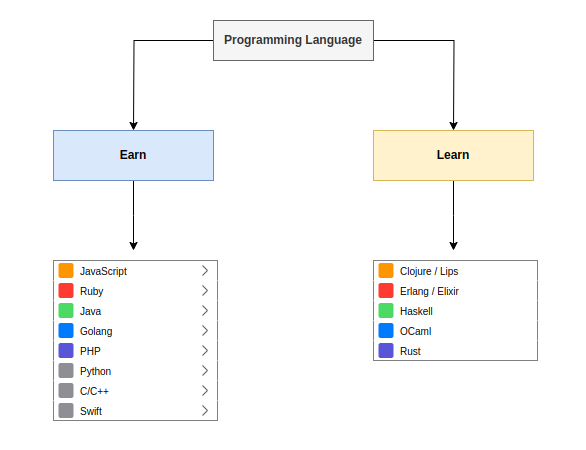The Perspective of Programming Language (in my point of view)
19 Aug 2023Introduction
Programming languages serve as the backbone of the digital world, enabling us to create complex software systems, applications, and tools. They provide the means to communicate with computers and instruct them to perform specific tasks. However, beyond their utilitarian role, programming languages hold distinct perspectives that shape their purposes and applications. In this article, we’ll delve into the perspectives of programming languages and explore how they can be classified based on their functions and benefits.
The Classification of Programming Languages
In my perspective, programming languages can be classified into two main categories of puprose: those used for earning and those used for learning. Let’s examine each category in detail:
1. Programming Language for Earning
The first category encompasses programming languages that are primarily chosen for their utility in the job market. These languages are in high demand due to their relevance to industries and businesses. Developers proficient in these languages can find employment opportunities with ease and often become valuable assets to organizations. They can also take up freelance projects and contract work, contributing to their income. If you have skills in one or more of these fields, you can be easily hired by almost any big company and easier to find any projects out there.
These languages are well-suited for building applications, websites, databases, and software solutions that cater to real-world business needs. Companies often seek developers who are skilled in these languages to maintain, update, and create new software products. Popular examples include Python, Java, JavaScript, C#, and Ruby.
2. Programming Language for Learning
The second category comprises programming languages that are chosen for educational purposes, personal growth, and exploring the art of coding. These languages may not be as prevalent in the job market, but they provide a strong foundation for understanding programming concepts, logic, and problem-solving techniques. If you’re in this field, it’s mean that you are have passion already for programming languages.
Developers who choose languages from this category are usually driven by their passion for coding and a desire to expand their knowledge. These languages are often more versatile and used for academic purposes, experimentation, and creating personal projects. Examples include Clojure, Lisp, Elixir/Erlang, and Haskell.
The Interplay of Perspectives
Interestingly, the perspectives of programming languages are not mutually exclusive. Many developers start with a language from the “Learning” category to understand programming concepts better. As their skills evolve, they often transition to languages from the “Earning” category to apply their knowledge and generate income.
Moreover, the distinction between these categories isn’t rigid. A language initially chosen for learning can gain prominence in the job market as its applications grow. For instance, Python was initially popular among educators and hobbyists, but it has now become a sought-after language for web development, data science, and artificial intelligence.
Conclusion
The perspective of programming languages reveals the diverse motivations behind their adoption. Whether chosen for earning potential or learning opportunities, programming languages play a crucial role in shaping our technological landscape. By understanding these perspectives, aspiring developers can make informed choices about which languages to learn and how they can leverage their skills to achieve their goals, whether that’s a rewarding career or a deeper understanding of the world of coding.
